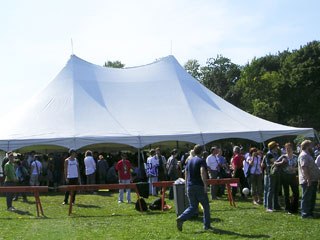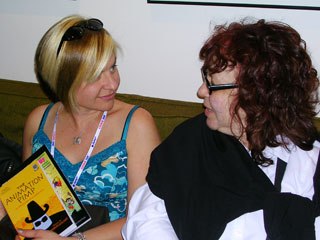Jon Hofferman reports back about his experience attending his first Ottawa International Animation Festival.
"The animation tent is shaped like a chapel. Animation has been a sanctuary for me, provided me with a space to find, cleanse, confess, define, lose, and discover myself... Unlike the solid foundations of a church, this tent can be folded up, it can blow away, it's temporary..."
In fact, there actually was a tent at the Ottawa International Animation Festival, a temporary structure that was set up to provide some cover during the Animators' Picnic on Friday in Strathcona Park. Generally considered one of the highlights of the festival, the picnic featured hamburgers and hot dogs (not enough), beer (more than enough), the legendary pumpkin-carving contest -- this year won by a sculpted homage to one of the festival films (and the eventual winner of the Cartoon d'Or at Cartoon Forum), The Pearce Sisters -- and a prodigious number of people eating, drinking, schmoozing, networking, and, probably at least some of the time, sharing their love of animation.
It was the large population, as much as anything, that impressed me about this popular festival, now in its 32nd year. One hears constantly about the proliferation of audiovisual entertainment available on an ever-larger number of platforms, and of the increasing isolation of individual consumers, caught up in their own niche interests and personal delivery systems. And yet here were, I don't know, several thousand people coming together in what felt like a real, if impermanent, community to experience an art form that's easily available in so many other more accessible media. Maybe I just don't get out enough, but somehow it seemed like a significant phenomenon, which at least offered an alternate perspective on some conventional wisdom that I'd come to take for granted.
Sign of the Pimp
While I didn't make it to any of the nightly parties that may go part of the way in explaining the festival's perennial popularity, I did attend one special event that, while it likely didn't appear on most festivalgoers' radar, was a high point for me (and might resonate with habitual AWN readers). This was the art exhibition/reading/book signing connected with the recent publication of The Animation Pimp, a collection of columns written by OIAF Artistic Director Chris Robinson from 2000 to 2005 that appeared in these virtual pages. [Full disclosure: I edited Robinson's book.] Held at La Petite Mort Gallery, where some of Andreas Hykade's illustrations for the book were displayed, the event drew about 50 people -- which was pretty much the capacity of the space -- to a rather rundown part of the city. (Another exhibit on display across the room featured stark photographs of some of the neighborhood's male denizens.)
Ever the showman (despite his oft-expressed protestations to the contrary), Robinson clearly had a good time reading a few excerpts from the book, especially when he realized that some of the individuals who appear in thinly disguised -- and not always flattering -- form in the book were there in the room. But apparently no umbrage was taken, books were sold and signed, congratulations were exchanged, and -- no doubt energized by the incredible publicity engendered by the event -- the book moved from #346,274 in Amazon's sales rankings to #346,273. (Actually, as I write, the book is #86,192, which isn't all that bad).
Oh, and There Were Films Too...
By now it's old news that the big winners this year were Vincent Paronnaud and Marjane Satrapi's memoir of an Iranian childhood, Persepolis, which took the prize for best animated feature, and Koji Yamamura's Franz Kafka's A Country Doctor, which won for best independent short. While I appreciated many things about both films -- in particular Persepolis' evocation of Iranian history and politics and Yamamura's extraordinary graphic design sense -- I found the former rather too conventional in its characterizations and narrative development, and the latter frustratingly obscure and difficult to parse. Obviously others disagreed. Perhaps another viewing of Yamamura's film would render it less opaque.
In what was overall a strong collection of shorts, the high degree of craftsmanship was impressive and the wide variety of styles and techniques demonstrated that the hegemony of figurative CG animation isn't complete, at least in the microcosm of personal short films. The one thing that seemed apparent was that distinctions between traditional styles of animation are becoming increasingly less meaningful. (This probably won't come as a revelation to most people who visit this site.) More and more, the trend seems to be toward mashups that combine (and sometimes integrate to excellent effect) various kinds of animation. One of my favorites in this category was Ian Mackinnon's Adjustment, an obsessive exploration of the breakup of a relationship told through animated objects, 2D computer, live-action, flipbooks, time-lapse and CGI.
Adjustment was part of Competition 1 (the shorts are divided into five groups) and, while one can't discount the burnout factor in a marathon viewing of films (i.e., by the time you get to Competition 5, everything can start to blur), this first group screened had a surprisingly large number of very good films. Of these, only the Japanese music video OOIOO "UMI"won a well-deserved award, but I was also partial to the politically astute Waif of Persephone, a funny retelling of the classic myth that was a virtual compendium of iconic references, and the very short 3D Pressure Cooker, a breathlessly kinetic chronicle of a hapless hen's race through a kitchen. Though it was officially part of Competition 1, due to technical difficulties Aaron Augenblick's award-winning Golden Age wound up being screened in segments throughout the rest of the festival. Fortunately, given the film's episodic nature, this in no way obscured its perfectly conceived and executed parody.
One genre one doesn't get to see much of that truly benefits from the big screen, abstract/experimental, was well represented here and, for me at least, offered some of the most compelling viewing. The award-winning Framing, aptly described by the judges as "a poignant love poem to a disappearing medium [i.e., film]," was among the best, but Thorsten Fleisch's Energy! -- an assaultive five-minute piece comprising "high-voltage discharges on photographic paper" -- was also terrific (if you like that sort of thing). Also of note was All That Remains by Stephanie Maxwell & Michaela Eremiasova, which employs a variety of media (cut-outs, animated objects, painting) to evoke a portrait of decay. At nearly six minutes, the film overstays its welcome a bit, but is very impressive nonetheless.
Finally, I was glad to see Doxology, a well-crafted, truly strange and highly atmospheric film that dares to ask the big questions -- about tennis balls, among other things -- pick up a prize. And, while it was largely text-driven, Don Hertzfeldt's Everything Will Be OK managed to transcend its literary underpinnings through great design and just the right inflection. Of his films I've seen, I think this is his best.
The Beginning
Apart from the picnic, the OIAF vibe (such as it is) was perhaps best captured at the opening ceremonies (such as they were) prior to the first shorts screening on Wednesday. Chris Robinson, ever the showman, explained that he had been asked by his publisher to write a blog from the festival, which would be posted on the Pimp book page on Amazon. Thus, as he delivered his opening remarks, a computer screen projected behind him displayed an alleged simultaneous transcript of his talk. A la The Colbert Report's "The Word" segment, however, what appeared on the screen was more a commentary (or, in some cases, an entirely unrelated digression) than an accurate record of what he was saying. The humorous effect was enhanced by the fact that whoever was doing the typing wasn't very good at it.
Following this travesty of protocol, the mood became more somber as the festival recognized two animators who died tragically this year. Paul Boyd, who was shot during an altercation with Vancouver police in August, was remembered by jury member Bruce Alcock, owner of Global Mechanic studios, where Boyd worked. And independent animator Heather Harkins memorialized her former teacher Helen Hill, who was murdered in January by an intruder in her New Orleans home. Also in Hill's memory, one of her films was shown before each shorts screening, a fundraiser was organized to benefit her young son, and the personable Harkins hosted a series of "tea parties" in her honor at the official OIAF hangout, the Russian-themed Avant Garde Bar.
Finally, Robinson introduced 2007 Honorary Festival President Hélène Tanguay, the much-loved "soul of NFB animation," who, after four decades at the National Film Board, was returning to civilian life. (On Friday, Hélène would be presented with a "memory box," containing messages from animators from all over the world.) One couldn't have found a better figurehead, or a more enthusiastic ambassador of animation, and Tanguay was a visible presence throughout the festival. Also, as part of her presidential duties, Tanguay programmed "10 Reasons to Love Animation," a selection of shorts -- ranging from Bob Clampett's 1938 Porky in Wackyland and Tex Avery's King-Size Canary (1947), to Oury Atlan, Thibaut Berland & Damien Ferrie's elegiacal 2004 film, Overtime -- that I was sorry to have missed.
Coda
"Even 10 years ago," says Robinson, "we were shooting the shit about the Internet coming and would this be the end of festivals, and I just never felt it was really an issue... This is a chance to come out and meet people and exchange ideas and have a meaningful connection... There is a communal atmosphere, that whole tent/chapel thing... It is a nice feeling to be in there with a group of people and experience this thing together."
Jon Hofferman is the interim editor of AWN.













